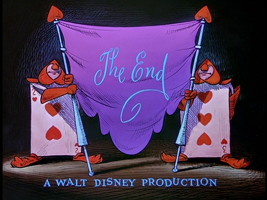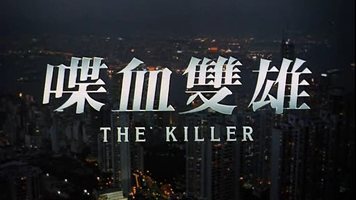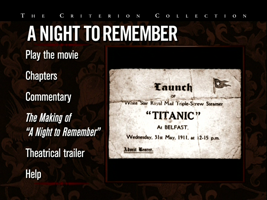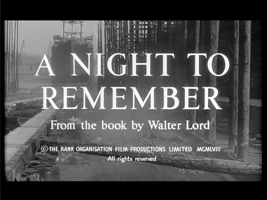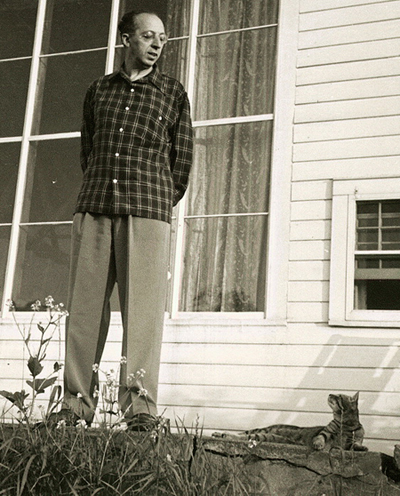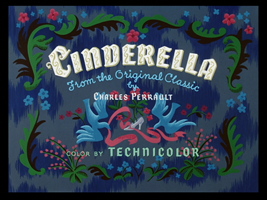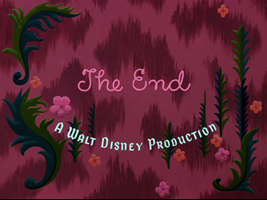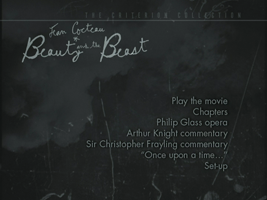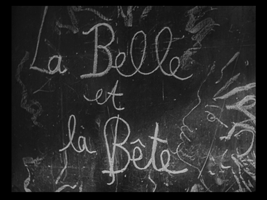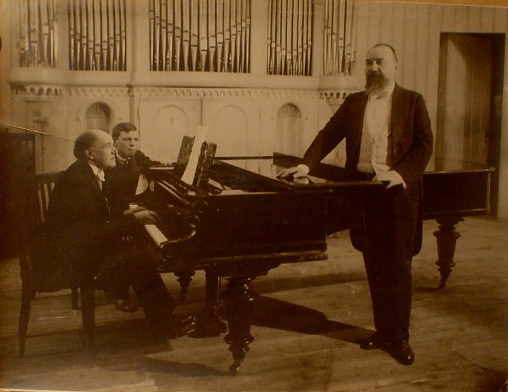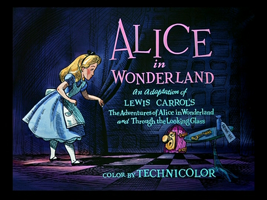
(note the misspelling!)
BROOM We have a guest today.
MIKE Hello.
ADAM I didn’t think that was very successful.
BROOM Well, I’ll begin by saying that I thought it was great.
BETH I thought it was really good.
ADAM Really?
BROOM And Mike, do you want to have a first word in before we start elaborating?
MIKE I thought it was long.
BROOM It was, for the record, seventy-five minutes long. But Mike did manage to take two breaks, so it might have seemed longer to him. Adam, I think you should complain before we praise.
ADAM To me one of the most compelling parts of the book Alice in Wonderland is the sense of malice that emanates from all the characters, which is only imperfectly translated here. The queen is certainly malicious, but everyone else… It just loses some of its delicious arbitrariness.
BROOM Certainly they Disney-fied it. When I was a kid, I was aware of the softer tone of the movie as compared to the book, but while watching it now, I didn’t feel like the differences from the book actually detracted from the pleasures of this movie itself. The fact that it wasn’t totally arbitrary, that she’s sort of on a quest after the White Rabbit the whole time, that she explicitly says “I want to go home,” which she never says in the book – I didn’t think that was actually problematic.
ADAM I guess. The other thing I love about the book is the wonderful wordplay and wit, which is hard to translate into a movie.
BROOM But just having any of that wit in it made this movie so much livelier than many other Disney movies. By borrowing one-fiftieth of the wit of the books, they made the movie seem full of interesting material. And delightful, to my mind.
BETH It was so different from any Disney movie we’ve seen. I thought it felt a lot more daring.
BROOM Well, it wasn’t totally different, if you think of it as Pink Elephants and The Three Caballeros having a baby.
MIKE Have you watched Fantasia yet?
BROOM Right, and quite a few things in Fantasia.
BETH Yes, but it was new that it was a full-length – or Disney-length – narrative entirely in that style.
ADAM It did feel packed with incident.
BETH Also, I didn’t like this at all when I was a kid. It felt like I was in a nightmare. I was supposed to sympathize with Alice, and I couldn’t bear to. Placing myself in her position made me feel horrible. I felt like I needed to get out.
BROOM In every sequence? Even when she’s just going into the White Rabbit’s house?
BETH Yes.
ADAM I can see that. That’s what I meant by “the malicious arbitrariness of it.” Maybe it would be too hard to give kids the full brunt of it. I mean, it’s terrible! With Cinderella, [Broom] said it struck him that the subtext is that she’s an abandoned child and this close to being killed – well, Alice is in deep shit for most of this movie!
BROOM But she’s not, because we know that she’s asleep, and then the movie tells us at the end that she’s asleep, that it’s just a dream.
BETH I didn’t know as a child that she was asleep. I had never read the book.
BROOM Let’s just talk about the movie and not the book for a second. At the beginning of the movie, she actually says, “I want to go to a place where everything is nonsense.” And then she goes there, and people are rude to her, and she deals with it. It shows what her opinion of it all is, which is like “These talking flowers are such snobs!” – just ordinary irritation. Then it gets to the point where she weeps and sings a song about wanting to go home, about not having followed her own good advice.
BETH That’s before the flowers.
BROOM When she first weeps, it’s in front of the doorknob, but I’m talking about when she sits in the woods singing.
BETH Oh, yes.
BROOM Badly singing. Kathryn Beaumont can’t sing and they have her sing anyway, and it’s a little bit sad.
ADAM Mike’s take on it was different from ours, though. You said you had a million things you wanted to say.
MIKE It was like a hyper-sexual über-trippy fantasy.
BROOM I heard you making drug jokes. And I know that the history of the movie, as Adam read the other day, is that it didn’t do well at first, and Disney shelved it, but then they got a lot of requests for private screenings, so they rereleased it as a drug-trip movie.
MIKE Has anyone written about the cryptic messages in Disney movies?
BROOM I’m sure they have.
ADAM What do you mean?
MIKE Well, the caterpillar who’s smoking a hookah –
ADAM Which is perfectly legal!
MIKE – and then offers up mushrooms to eat; it’s all suggestive of a certain lifestyle.
ADAM Right, but that’s all Lewis Carroll. That’s not Disney’s fault.
BETH Also, psychedelic drugs weren’t really around in 1951. I know the hookah was, but…
BROOM Well, the hookah was written into the book in 1865.
BETH Right. I don’t know if mushrooms were a phenomenon yet.
BROOM I think if psychedelic drugs were a thing at the time, they wouldn’t have made this movie. They would have talked about it and realized, “we can’t do any of this stuff; we don’t want to be associated with that.” I think the movie was clearly made in a state of innocence.
MIKE I don’t know. I think it was only in the 50s that you first had the anti-drug movement.
BETH In 1951? Really?
MIKE Yeah, I think it wasn’t until the late 50s that you even had the state entering into controlling these sorts of things. I mean, certainly in the late nineteenth/early twentieth centuries, cocaine was quite a widely-distributed substance.
BROOM Right, but that’s why there wouldn’t have to be any innuendoes about it. The movie wouldn’t have to have a secret subtext about drugs; if it had wanted to be about drugs, it would have openly been about drugs. I think the “Hey man, you know what’s really going on in that movie?” winking attitude didn’t exist yet. So I can’t imagine that’s what’s really going on in this movie.
ADAM It’s just like when Disney inserted that penis in the Little Mermaid’s castle!
BROOM You know that’s one of the few real ones? I believe that unlike most of those rumors, that one was really put there intentionally by a poster artist to see if he could get away with it. [Ed. Nope.]
ADAM And aren’t there clouds in The Lion King that say “Have More Sex?”
BROOM The cloud in The Lion King says “SFX,” which is supposed to be a shout-out to the special effects department that animated it, but that wasn’t well thought out on their part. [Ed. Snopes says: undetermined.]
MIKE I was surprised by the parallels to The Wizard of Oz.
BROOM Wait; before you go into that, what did you mean about sexual content? I didn’t see anything sexual about this movie. She’s like the least sexual Disney heroine of all, and that includes Snow White.
MIKE Oh, I think Alice is totally this vamped-up sex kitten.
BROOM Okay. But seriously folks, what did you mean?
MIKE Maybe I’m imposing back on to her what they’ve done to her since then. You know, if you think about references to Alice today, they’re often in the form of adult Halloween costumes, or, like, Gwen Stefani in a music video wearing a short short skirt.
BROOM But this movie predates those things and also contains none of those things. I dare you to say where you saw that in this movie. I dare you.
MIKE Well, her figure itself is Barbie-esque.
BETH She has no breasts. I was looking for them. She really has no figure.
MIKE But she has very thin arms, and very big eyes, and sensual hair.
BROOM She is certainly older than the Tenniel drawings, or than the historical Alice, who was six-and-a-half or something.
BETH She looks like she’s eleven, to me. She seems to be pre-pubescent.
ADAM She’s pretty.
BETH They did make her pretty. But her head was too large for her body, and I think that was to make her seem more like a child.
ADAM She’s prettier than the queen, who looks a lot like the dinosaur from, uh…
MIKE She’s like Britney Spears circa “Hit Me Baby One More Time.”
BROOM No! There’s nothing coy about her. She’s all on the surface.
ADAM The queen looks like the steam shovel from that children’s book.
BROOM “Mike Mulligan and His Steam Shovel?” Because she has that jaw that looks like it’s going to scoop things up. In my animation class in college, a guy came in and showed us preliminary art toward a movie he was going to make, which was all imagery of a young Victorian girl walking around an estate and looking at peculiar stuff. And I eventually asked, “is there a reason that you’re not just doing ‘Alice in Wonderland’? Why aren’t you even mentioning that as a point of reference? This looks just like it.” And the guy was dismayed and said, “Really? I never really liked ‘Alice in Wonderland.’ ” And the teachers and everyone else sort of chimed in, saying, “Who actually likes Alice? Nobody cares about her.”
ADAM As a character.
BROOM Yes. They didn’t care about the “Alice in Wonderland” universe, they were saying, because Alice is a nobody.
ADAM That’s not true!
BROOM And I realized then, and said, that I like Alice because she has this indomitable six-year-old – or eleven-year-old – attitude.
ADAM “Don’t be ridiculous!”
BROOM Yes. “I’m not a flower at all!”
BETH It’s so British. Maybe that’s why Americans might not like her, because she’s a kind of snotty British kid.
ADAM I do think that the book Alice is tarter, just the way that the book Mary Poppins is tarter than Julie Andrews.
BROOM It’s not tartness that I like about the character. It’s the way she parses all of this real chaos in terms of “well, that simply doesn’t make sense.” Not a snobbish superiority to it, just a directness. She is correctly reacting to the fact that it doesn’t make sense, but on a scale much lower than the scale on which it’s nonsense, and that seems like power. It makes her seem in command.
BETH I like her character, and I liked this movie. But I’m saying that maybe the reason that other people might not is because she has a snobby British quality.
ADAM Whereas, to be clear, I’m saying that I thought it was too Americanized.
BROOM You started laughing at the “Alice in Wonderland” song, right at the beginning.
ADAM Well, the songs were not successful.
BROOM I think several of the songs were very successful.
ADAM [caterwauling]
BROOM That’s your impression of the choral singing?
ADAM Yes.
BROOM I think that “The Unbirthday Song” works very well. Not just because, as you said, it has primal associations for you with the Teacups ride.
ADAM Ohhh. I love the Teacups more than anything else at Disneyland.
BETH Why?
ADAM It’s a great, great ride, and I’ve been on the Teacups so many times.
BETH The spinning thing? That’s your favorite ride?
ADAM Because you can get it so that it spins one way while you’re going the other way.
BETH Right, because it’s on a plate too.
ADAM And you can cause yourself to whip around, like a planet in orbit.
BETH That is fun.
BROOM I don’t know how they produce that sound – I remember that when I was at Disneyland on the Teacups, I was trying to figure out what instrument it was making that thick tooting sound. It might be some kind of an organ, or they might have built their own pipes. Anyway, it’s a perfect sound for teapots playing a song. As soon as it started, Adam went into a reverie about the ride. That’s a very nice little song.
ADAM You’re right, that is a nice song.
BROOM And there are a couple other ones. Like, “We’re Painting The Roses Red” is sort of catchy. And I know that “All in the Golden Afternoon” is rather bad, but I do find myself humming the tune of “you can learn a lot of things from the flowers, for especially in the month of June.” I guess you guys don’t. And “Alice in Wonderland.” [Ed. and also the “Twas brillig” tune] I think I watched this movie more than the others when I was a kid.
ADAM This would have appealed to your parents’ style of parenting, I’m guessing.
BROOM My parents? I think it just appealed to my style of being a kid. It was full of incident, as you said, and that was the primary criterion.
BETH I actively tried to avoid this movie. It really upset me.
BROOM Once you’ve seen it, you know that nothing actually scary happens in it. The scariest things in other Disney movies were when people’s faces would become skull-like, or their eyes would glow or whatever, and there’s none of that here.
BETH That’s what scares you. Those types of things don’t scare me.
BROOM That is what scares me: people pulling faces. And there are no pulled faces in this.
ADAM There’s only the sense that the world is arbitrary and hates you, or at least wants nothing to do with you, and that even sympathetic people couldn’t care less about you.
BROOM But what I find invigorating about it still is that it’s not wholly to be understood that way, as though it’s a world; it’s also very much about the visuals. It’s about the excitement of animation going “boing.” During the ballet of the cards, their marching sequence, it’s pretty abstracted. We know what the story space looks like at that point, and they’re not in it. It’s just cards in patterns, Busby Berkeley style, but even more abstract. Or when she first lands and the room is all skewed, it’s just for the visual play. The movie keeps going there and telling us that these are just images, but lets that overlap with the realm in which she’s actually being threatened by the chaos. I find that very satisfying.
ADAM The images are heavily indebted to the original illustrations. Disney didn’t come up with most of the visuals.
BROOM Well, they found their own renditions of some of the same scenes. I mean, this movie doesn’t look that much like those drawings, either. And, you know, the doorknob with a face and lots of other things are just pure Disney, as far as I’m aware. And those weird beachscapes, where a little stone creates a long shadow like in a Dalí painting – that’s a very Disney thing to do. When the doorknob tells her that she left the key on the table and we see it appear, through the bottom of the glass table – when I was a kid, I couldn’t understand what we were seeing; it always looked to me like the key was stuck to the underside of the table, and I couldn’t understand why. But this time it looked fine. I don’t know what was wrong with my head, as a kid.
ADAM Mike, was the caterpillar your favorite part?
MIKE I don’t know that I had a favorite part. I was struck that there was a moral in the middle of the movie that I wasn’t expecting – because I don’t really have strong memories of seeing this as a kid.
ADAM “Don’t be so damned curious?”
MIKE No, there was this whole thing about reason. “I shouldn’t have allowed myself to be undisciplined and fall off the path. I find myself lost and confused in this world that’s spinning around me.”
BROOM That was just bullshit to justify that one song. Because it doesn’t fit with the rest of the movie.
MIKE Well, it does tie in with the beginning, where she wants to go to a nonsensical world and not listen to her lessons.
BROOM I guess you’re right. But the movie is just not coherent on that level, because the rest of it is sort of a celebration of nonsense.
ADAM No, it’s a refutation of nonsense. Alice hates nonsense. She sees it and says, “that’s nonsense!” And ultimately she triumphs over it.
BROOM Wait, when does she say that?
MIKE With the flowers.
ADAM Right, or the Mad Hatter. “But I haven’t had any tea!”
BROOM It’s odd that at the end, we don’t get to find out her reaction upon waking up. She doesn’t get to say either “I was just in the most wonderful place!” or “I’ve learned my lesson and I’ll never do that again!” It just isn’t clear what this version of Alice is learning from her experience. In the books – in both books – she wakes up and is eager to talk about all the wonderful things she’s seen, because she loved it.
MIKE Did Walt Disney have any intention of using his movies for education? Or did he just have this pure concept of entertainment?
BROOM Well, I don’t think this movie had any educational content, but he made a lot of educational films. In fact, when we read the Times review, you’ll see that this was paired with an educational short when it first came out.
BETH You already read the Times review? I’m eager to hear what Bosley has to say.
BROOM I’ll give away that Bosley is reasonably positive, as with all the other ones, but I do know that it didn’t do well on first release, and I don’t know if that’s because it didn’t do well critically or just didn’t match the public mood.
ADAM You think it wasn’t what people wanted from a Disney movie?
BETH It might be because kids found it upsetting, or couldn’t understand it.
BROOM I’m personally impressed by the fact that it has no plot, that it creates a sense of structure without one. At the end, Adam said, “this feels climactic,” because it was sufficiently frenzied, and the movie worked on that level the whole time. The things didn’t relate to each other logically, so they had to just give you the feeling of form – musically, so to speak.
BETH Again, I liked it this time, as a grown-up, but not as a kid.
ADAM I said it during the screening and I’ll say it again now, that according to IMDB, there was a Jabberwocky scene planned, but it was scrapped because it was too frightening. I can only imagine.
BROOM I would have been happy to buy this, but it has gone out of print for the time being so we had to Netflix it, and we only got the first disc of a two-disc set. The second disc might have materials from that segment.
BETH You might be able to find it online. [Ed.: only the non-scary preparatory art here.]
BROOM I think that the Mary Blair designs looked fantastic.
ADAM What in particular?
BROOM Well, in the middle of the scene where Alice is the monster in the White Rabbit’s house, you see the sky for a second, and it’s not a normal sky color. It has nothing to do with what’s going on, but the sky is sort of a gray field with white squares. It’s a middle-of-the-day scene, but there’s a sort-of-night sky and the trees are a funny color, and that’s just one of many backgrounds that go by in that sequences. It gives you the intense feeling I got from picture books, as a kid, where the whole space would be colored. The sky isn’t just the sky, it’s color and it makes an impression. There was stuff like that going on throughout the movie, and I think I responded to that when I was young too.
ADAM We’ll see that again in Bolt.
BROOM Just comparing this to Cinderella, I think it’s a really good an encouraging direction for the studio. To say, “We’re not just going to make…”
ADAM “Princess movies.”
BROOM I don’t think they were specifically deciding between princess movies and other movies. More generally, “we’re not just going to make kids’ movies.” It’s a kids’ movie, but it had the most life in it that we’ve seen since The Three Caballeros. Which covers seven years.
BETH Except for the dress!
BROOM What did you think of the costumes?
ADAM I don’t know. Nobody ever made a pinafore look so good.
BROOM Actually – maybe I’m reading too much into this – but I feel like they might have been sort of refuting Cinderella‘s attitude toward animated movies, in that the sister who’s reading her the lessons is a rotoscoped, realistic person, and Alice isn’t particularly. And then Alice goes into a world that has no room for anything at all like that, and when she comes back out, we’re aware that the traced human world is boring by comparison, and it’s what all of Cinderella looked like. That it’s the ground level from which we descend into something much more entertaining and vibrant. Anything else?
ADAM I’m a little defensive about “Alice in Wonderland,” because I think it’s such a wonderful work. I’m like one of those Star Trek: The Movie people.
BROOM Anti- “The Movie” because it’s not as good as the show?
ADAM Just highly protective of it.
BROOM So you feel like this abused the real property?
ADAM No, I don’t really. I must say that I’m struck that it is as faithful as it is.
BROOM I’m surprised that they put in the actual story of “The Walrus and the Carpenter.” Although they did louse it up by having them sing “We’re cabbages and kings!” at the end of every verse, and then as a coda.
ADAM And it was a little more winking than the poem. “The Walrus and the Carpenter” is supposed to be funny because the walrus is supposed to seem deadly sincere until the end. He’s not supposed to leer like that.
BROOM They telegraphed the whole thing. I actually found that one of the scariest parts, because you couldn’t tell what was going on other than that it was cannibalism of children. The whole time, they’re insinuating, “you know what we’re going to do at the end of this scene… Eat all of the innocents!” The rest of the movie didn’t bother me much.
ADAM When she’s in the forest and nobody gives a shit about helping her, that’s upsetting.
BROOM I love when that creature, that sweeper dog comes and erases the trail. That’s the biggest kick-in-the-gut moment in the movie, and it’s also so cool. She thinks she’s following this trail, but all it takes is a sweeper dog to ruin that. And it has that great brush music that goes with it. I love that moment. But it is upsetting.
ADAM The flowers remind me of Dumbo’s mother’s friends.
BROOM You always like the haughty socialites.
ADAM The flower archetypes map on to the individual elephants. The rose is the one who says “Girls, girls!”
BROOM No, the one with the lorgnette.
ADAM Oh, right, the Iris, you mean.
BROOM The Iris, yes. Don’t get me started about the Irish! I still don’t know Disney thinks about the Irish. I don’t know what it means. I’ve been referring to Tweedledum and Tweedledee every time we saw someone Irish before, and here they were.
BETH They were Irish, yes.
BROOM What does it mean? They bounce off each other’s bellies.
ADAM Really? I hear Scottish.
BETH Oh yeah, you know what? I thought they were Irish, but then later in their performance, I thought maybe they were actually Scottish.
BROOM The tufts of red hair mean they’re Scottish?
BETH Their accents.
BROOM Really? I thought something about them talking in squeaky nasal voices meant they were supposed to be Irish.
BETH They pronounced something in a Scottish way.
BROOM Oh.
ADAM We just rocked [Broom]’s world. It is interesting that this was the first really ethnically specific movie. I know Cinderella was set in France, but here they were all really ethnically British.
BROOM They were?
ADAM She had a British accent. Bill was Cockney.
BROOM Was the Dodo an American, then? Was he a colonial?
ADAM I felt like they were all British archetypes.
BROOM Why does the Dodo have a powdered wig? He’s a seafaring man?
ADAM He’s just a “cap’n.” I don’t know.
BROOM Anyway, I just thought that was fantastic. A real return to form. A new form – not quite the art-object form that Bambi or Fantasia was trying to be, but something very satisfying.
ADAM Let’s see what Bosley has to say.
–[the Times review is read]–
BROOM Makes you kind of want to see Nature’s Half Acre, doesn’t it?
BETH No.
BROOM Well, you can’t see it. It’s not on youtube and it’s not on DVD. Which is sad.
ADAM When are we going to lose Bosley?
BETH In the seventies, I think. [Ed.: retired 1968]
MIKE Remember when Disney used to take over whole days – school holidays – and do a broadcast on a network like ABC from 8 in the morning until 5 at night?
BETH and BROOM No!
BROOM About one thing? Or just show their movies?
MIKE It was everything from “Exploring the Redwood Forests” to bizarre animated shorts.
ADAM This is not the same as when the Disney Channel was free for 96-hour windows, is it?
MIKE No, because we didn’t have cable until I was sixteen. This would have been on ABC.
BROOM They definitely had a relationship with ABC. We used to watch the Disney Sunday Night Movie.
MIKE This would have been around then. Not necessarily the Michael Eisner years.
BROOM I don’t remember that, but that’s cool. Maybe you saw Nature’s Half Acre then. Any thoughts about Bosley’s opinion?
ADAM No. It seemed about right.
BROOM It reminded me of something I wanted to say but I can’t remember what…
BETH …Time’s up.
BROOM Okay, time’s up. See you next time with Peter Pan.
ADAM and BETH Oh no!
